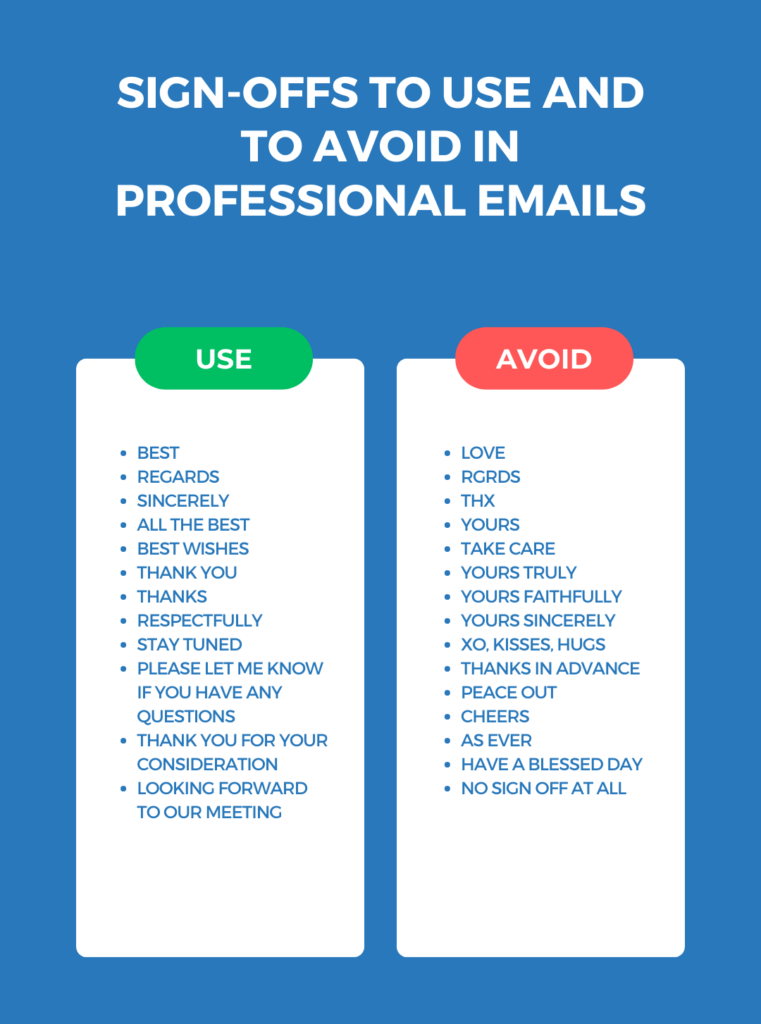Emails are usually the main form of communication used in most businesses. However, sending a new employee, client, or supplier an email may require a level of professionalism you don’t necessarily practice with your close colleagues.
Let’s say you’ve completed the body of the email, and it’s slick. However, all of the endings you can think of don’t sound right for this email. They don’t match its efficiency, and at the same time, you don’t want to end in a questionable tone.
What are the proper ways to end an email professionally? Let’s take a look at email closing examples, tips, and what to avoid.
What Are Professional Email Closing Phrases?
Professional email closing phrases are words you use at the end of an email with the aim of ensuring that the receiver leaves with an understanding of what the next step should be. You do this by reminding the reader what the purpose of the email is and adding a call to action.
Email closing phrases are important because they give the receiver a sense of direction. They should know what to do after receiving the email. This way, you won’t have to send follow-up emails asking for a response or confirmation. Whatever needs to happen next needs to be clearly indicated in the end.
Email Sign-Offs to Use and to Avoid
Email sign-offs are all about who you’re sending the email to. If it’s someone you don’t know, keep it professional, especially when it’s business-related. Here are professional email sign-offs to use:
- Best
- Regards
- Sincerely
- All the best
- Best wishes
- Thank you
- Thanks
- Respectfully
- Stay tuned
- Please let me know if you have any questions
- Thank you for your consideration
- Looking forward to our meeting
If you have other more professional email sign-offs in mind, then great, but remember to avoid the following:
- Love
- Rgrds
- Thx
- Yours
- Take care
- Yours truly
- Yours faithfully
- Yours sincerely
- XO, XOXO, Kisses, Hugs
- Thanks in advance
- Peace out
- Cheers
- As ever
- Have a blessed day
- No sign off at all

Examples of How to End an Email
There are various scenarios where one needs to send a professional email. Some email sign-offs and phrases for ending a professional email may be great for specific scenarios. Hence, we have made a list of email closing examples with professional email sign-off examples relating to specified cases.
A Team Update
A Networking Email
Response to a Meeting Request
Tips for Closing Emails Professionally
The professional emails you have to send won’t always be the same. You’ll deal with different kinds of people, contexts, and scenarios every now and then. The few examples we’ve provided above were to give you an idea of how to end an email professionally.
The tips below will give you a broader idea of how to end an email, regardless of the professional case.
Grateful Yet Guiding Closing Phrases
Thank the recipient and add a call to action so they know what the next step is after reading the email.
Share Contact Details
Though the email receiver automatically gets your email address the first time you send them an email, it’s important to include alternative contact details like your phone number.
Keep Away From Unprofessional Sign-Offs
Your business or professional environment should be kept like that. Communicating in a professional manner can help prevent certain boundaries from being crossed. So, avoid signing off with cheers, thx, XO, your friend, and other casual email sign-offs.
Final Thoughts
Emails are the best way to communicate with colleagues, clients, and suppliers within a business. The trick to a professional email can sometimes be the closing because it can be hard to figure out how to properly end an email.
Think about what’s more appropriate for the receiver. Hence, we’ve created the examples and provided you with the tips above to give you an idea of how to properly end an email. Your closing phrases should have a tone of gratitude and present a call to action that’ll help clarify what the receiver should do next.
Finally, close it with a professional sign-off and your details, including an alternative contact. Once you get the hang of professional closings, you can close deals and enhance your sales through the InboxCRM Chrome extension by PandaDoc.


